Meningococcal ACWY (MenACWY) vaccine coverage for adolescents in England, academic year 2022 to 2023
Updated 23 January 2025
Applies to England
Main points
This report presents vaccine coverage data for the routine school-aged MenACWY immunisation programme in England for the 2022 to 2023 academic year (2022/23). These results include MenACWY vaccine coverage estimates for children in years 9 and 10 (or the equivalent ages) measured up to the 31 August 2023.
The main findings of this report are that:
- MenACWY coverage for year 9 students during the 2022/23 academic year was 68.6%, which is 0.6 percentage points lower than the year 9 cohort in 2021/22 (Figure 1)
- MenACWY coverage for year 10 students during the 2022/23 was 73.4%, which is 6.2 percentage points lower than the year 10 cohort in 2021/22 (Figure 1)
- MenACWY coverage in year 10 students was 4.2 percentage points higher than in the 2021/22 when they were in year 9
- MenACWY coverage in year 9 students was highest in the South East (75.4%) and lowest in London (60.4%)
Introduction
An increase in meningococcal W (MenW) cases led to the Joint Committee on Vaccination and Immunisation (JCVI) advising that the routine adolescent meningococcal C (MenC) dose should be replaced with the quadrivalent MenACWY conjugate vaccine in 2014. In February 2015, JCVI further advised an emergency catch-up programme with the MenACWY vaccine for children in the higher school years.
In August 2015, a MenACWY catch-up programme began for all children aged 14 to 18 years and those aged under 25 years attending university for the first time (1, 2). The NHS MenACWY immunisation programme aimed to immunise all eligible cohorts through a series of school and GP catch-up campaigns.
The first of these MenACWY vaccination catch-up campaigns started in August 2015, targeting those born between 1 September 1996 and 31 August 1997. A second GP-based catch-up campaign started in April 2016, targeting those born between 1 September 1997 and 31 August 1998. The final catch-up campaign started in April 2017 for those born between 1 September 1998 and 31 August 1999. All these cohorts remain eligible for MenACWY vaccination up to their 25th birthday.
The routine school-based adolescent immunisation programme began in 2015. NHS England (NHSE) commissions school-aged providers to deliver this programme in schools across England. Adolescents who are home-schooled, those who attend a small minority of schools that do not offer the routine vaccination programmes, and those of eligible age but not in education should be offered their vaccinations in alternative settings, such as community clinics. The eligibility criteria and delivery models used for the MenACWY school-aged programme have changed over time and more details on these changes can be found in the Appendix.
Since March 2020, the coronavirus (COVID-19) pandemic has led to some disruption of school-based immunisation programme delivery and the impact has varied by region and local authority. The biggest impact was observed in the 2019/20 academic year when all schools were closed in the first national lockdown (3). Throughout the 2020/21 academic year, school attendance rates in England were lower than normal. In January 2021, schools were closed to all, except children of keyworkers and vulnerable children, with a phased reopening of secondary schools from March 2021. Staff absences in both schools and school age immunisation services (SAIS) also added to the disruption.
Vaccine coverage in 2020/21 improved significantly but was still not back up to pre-pandemic levels. In the 2021/22, school attendance rates in England remained lower than normal until the ‘Living with COVID-19’ guidance was implemented from February 2022 and all restrictions were lifted (4). In September 2021, the offer of COVID-19 vaccination was extended to all children aged 12 to 15 years and was delivered in secondary schools and other settings (5). In addition, the influenza immunisation programme was extended to all children in secondary schools (6). School-age immunisation services were instrumental in supporting the delivery of all of these programmes under very challenging circumstances. It is likely that all of these factors combined impacted on the delivery of the routine adolescent immunisation programmes including the MenACWY programme.
Previous reports were published by Public Health England (PHE).
Methods
NHSE-commissioned school age immunisation providers collect school-level vaccine coverage data, which is then aggregated up to local authority and submitted to UK Health Security Agency (UKHSA) either directly by the providers or by NHSE Regional Public Health Commissioning Teams via the ImmForm website. Where possible, regional teams also include additional data for adolescents resident in the local authority but not linked to any school. Data providers may also submit data on vaccinations delivered through community clinics or GP practices and this can then be added to the school vaccination figures.
The numerator is defined by the number of adolescents in each cohort who had received a dose of the MenACWY vaccine by 31 August 2023. Providers must use updated data sources to identify all eligible children in the locality for the academic year. This can be calculated from school student records for all types of schools or units, plus children schooled at home, or Child Health Information Systems.
The denominator is defined by the total number of eligible adolescents in each cohort regardless of programme delivery. This means that adolescents in local authorities where NHSE commissioned school-aged providers did not run a MenACWY programme in year 9 or 10 are included in the coverage estimates.
Local authority level MenACWY vaccine coverage data up to 31 August 2023 was manually uploaded by data providers to the ImmForm website retrospectively, from 1 September 2023 to 1 October 2023. The target population for the programme is defined by school age cohorts born between 1 September 2007 and 31 August 2009 (Table 1). This means that it includes those adolescents in school years 9 and 10 in the 2021/22 academic year. Coverage for the year 10 cohort was intended to capture both vaccines delivered during 2020/21 (when the students were in year 9) and routine or catch-up vaccines delivered in 2021/22.
Full details of the data collection process and definitions can be found in the user guide.
Table 1. MenACWY vaccination cohorts in the 2021 to 2022 academic year
| School year in 2022 to 2023 | Age in 2022 to 2023 | Dates of birth |
|---|---|---|
| 9 (routine) | 13 to 14 years | 1 September 2008 to 31 August 2009 |
| 10 (routine or catch-up) | 14 to 15 years | 1 September 2007 to 31 August 2008 |
Results
Figure 1 shows the MenACWY vaccine coverage for year 9 (dark teal) and year 10 (cyan) students in England from 2015 to 2023. This data is also presented in text form in Table 2. MenACWY coverage for year 9 students during the 2022/23 was 68.6%, which is 0.6 percentage points lower than the year 9 cohort in 2021/22. For year 10 students, coverage was 73.4% in the 2022/23, which is 6.2 percentage points lower than the year 10 cohort in the previous year.
Figure 1. MenACWY coverage in adolescents in school years 9 and 10 by academic year from 2015 to 2023
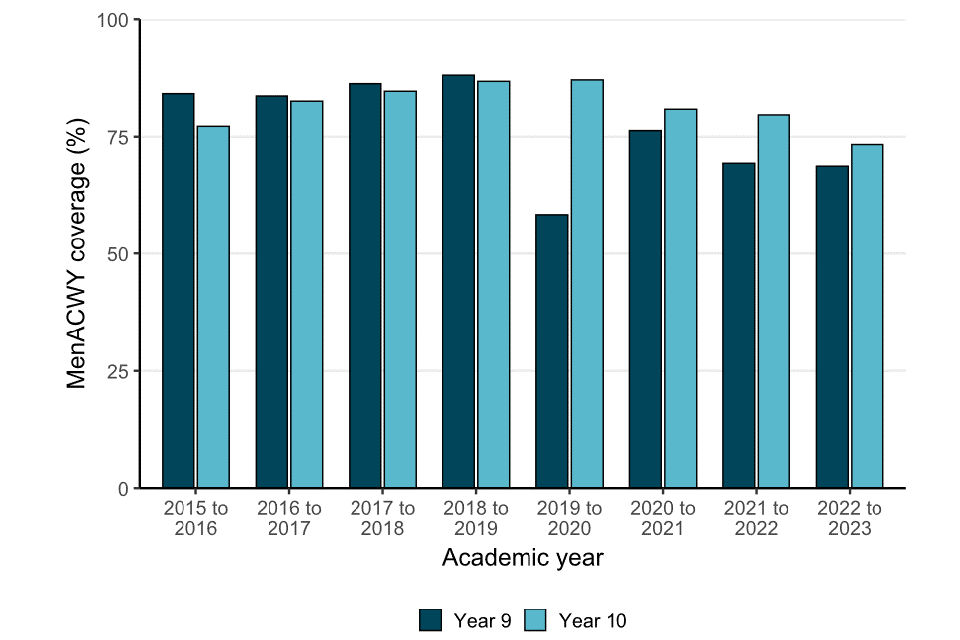
Table 2. MenACWY coverage in years 9 and 10 from 2015 to 2023 [Note 1]
| Academic year | Year 9 MenACWY coverage (%) | Year 10 MenACWY coverage (%) |
|---|---|---|
| 2015 to 2016 | 84.1 | 77.2 |
| 2016 to 2017 | 83.6 | 82.5 |
| 2017 to 2018 | 86.2 | 84.6 |
| 2018 to 2019 | 88.0 [Note 1] | 86.7 |
| 2019 to 2020 | 58.3 | 87.0 |
| 2020 to 2021 | 76.3 | 80.8 |
| 2021 to 2022 | 69.2 | 79.6 |
| 2022 to 2023 | 68.6 | 73.4 |
Note 1. In 2015 to 2016, only half of the year 9 and 10 cohorts were eligible for the vaccine meaning these figures are not comparable to later years. Also, over time many local authorities have moved from routinely offering the vaccine in year 10 to offering it in year 9. During transitional years, some local authorities offered the vaccine routinely to both year 9 and 10. This transition meant that in 2018/19, the year 9 data was incomplete meaning some local authorities were excluded from national coverage figures. Since almost all local authorities now offer the vaccine in year 9, the year 10 coverage figures in 2021/22 are the year 9 coverage plus additional catch-up. These changes mean that national coverage figures are not directly comparable over time and explain why coverage in the year 10 cohort may appear to decrease when compared to previous years.
Programme delivery
Year 9 vaccine coverage
The main findings for the year 9 cohort were that:
- MenACWY coverage for year 9 students in 2022/23 was 68.6%, which is 0.6 percentage points lower than year 9 students in the previous year (Table 2)
- MenACWY coverage in year 9 students was highest in the South East (75.4%) and lowest in London (60.4%) (Figure 2)
- local authority level coverage ranged from 92.3% (West Berkshire) to 0.4% (Greenwich) (this range includes those who only offer the vaccine routinely in year 10)
- out of 151 local authorities, coverage in 75 (49.7%) was less than 70%, coverage in 48 (31.8%) was between 70% and 80%, coverage in 24 (15.9%) was between 80% and 90%, and coverage in 4 (2.6%) was greater than 90% (Figure 3)
Figure 2 shows the distribution of MenACWY vaccine coverage in school year 9 by NHS commissioning region. Vertical black lines indicate the range of values among constituent upper tier local authorities (UTLAs) in each region, while the teal boxes indicate the range of the second to third percentiles, with the median indicated by the horizontal white line within each box. MenACWY coverage in year 9 students was highest in the South East (75.4%) and lowest in London (60.4%)
Figure 2. Year 9 MenACWY coverage by NHS commissioning region
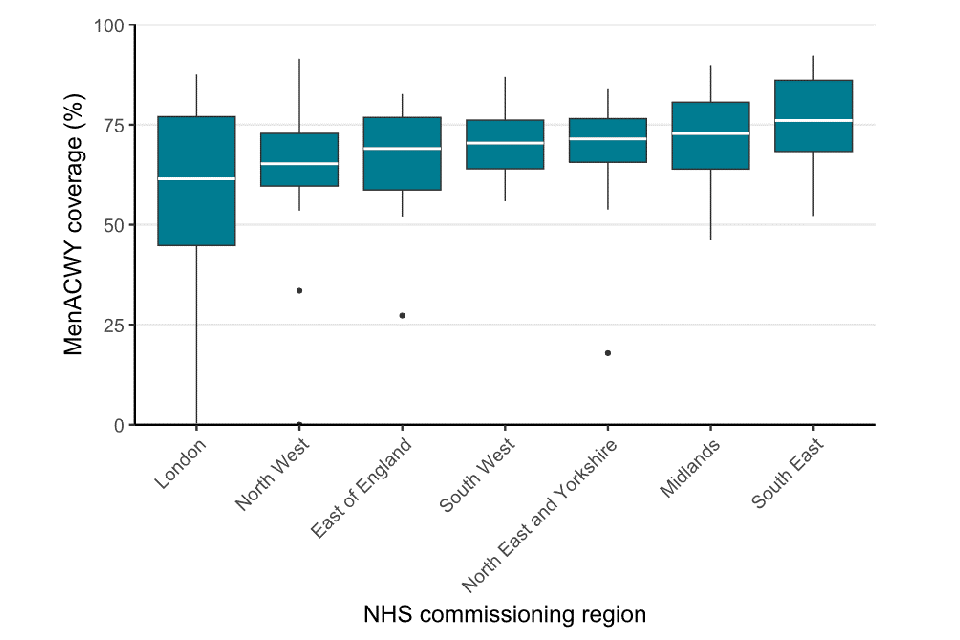
Note. In London, very few students are vaccinated in year 9 in the Greenwich borough (0.4%). This explains the skewed boxplot range for London.
Figure 3 shows the geographical distribution of MenACWY vaccine coverage at the UTLA level for year 9 students in England. Coverage within ULTAs ranged from 92.3% in West Berkshire to 0.4% in Greenwich (this range includes ULTAs who only offer the vaccine routinely in year 10).
Figure 3. Map of year 9 MenACWY coverage by local authority
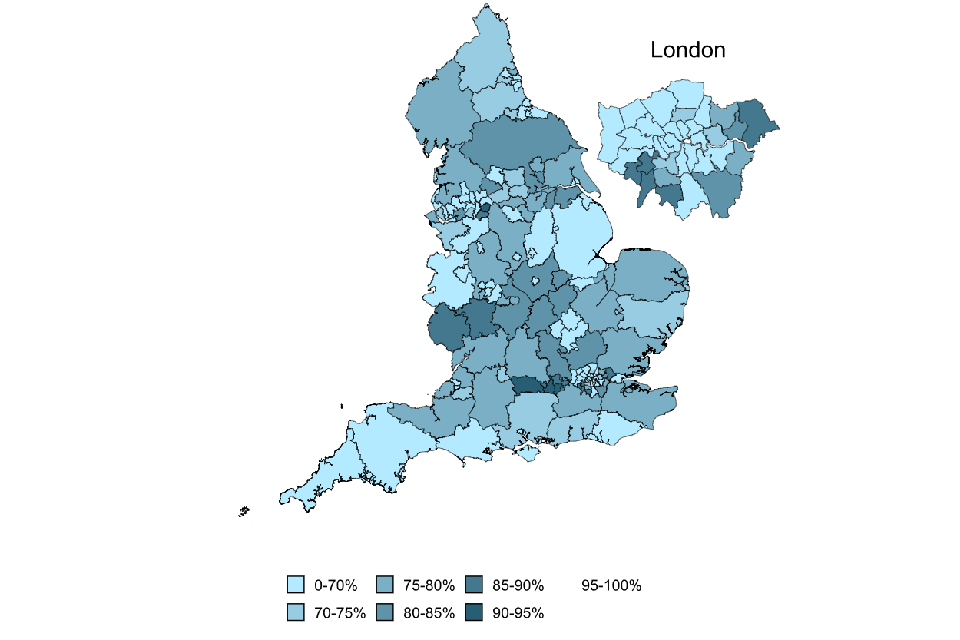
Note. MenACWY coverage did not exceed 95% for Year 9 students in any UTLAs.
Year 10 vaccine coverage
The main findings for the year 10 cohort were that:
- MenACWY coverage for year 10 students in 2022 to 2023 was 73.4%, which is 6.2 percentage points lower than year 10 students in the previous year (Table 2)
- MenACWY coverage in year 10 students was 4.2 percentage points higher than in 2021 to 2022 when they were in year 9 (Table 2) suggesting ongoing catch-up activities
- MenACWY coverage in year 10 students was highest in the East of England (83.0%) and lowest in London (65.4%) (Figure 4)
- local authority level coverage ranged from 96.3% (Hertfordshire) to 29.6% (Westminster)
- out of 151 local authorities, coverage in 68 (45.0%) was less than 70%, coverage in 35 (23.2%) was between 70% and 80%, coverage in 38 (25.2%) was between 80% and 90%, and coverage in 10 (6.6%) was greater than 90% (Figure 5)
Figure 4 shows the distribution of MenACWY vaccine coverage in school year 10 by NHS Commissioning region. Vertical black lines indicate the range of values among constituent UTLAs in each region, while the teal boxes indicate the range of the second to third percentiles, with the median indicated by the horizontal white line within each box. MenACWY coverage in year 10 students was highest in the East of England (83.0%) and lowest in London (65.4%).
Figure 4. Year 10 MenACWY coverage by NHS commissioning region
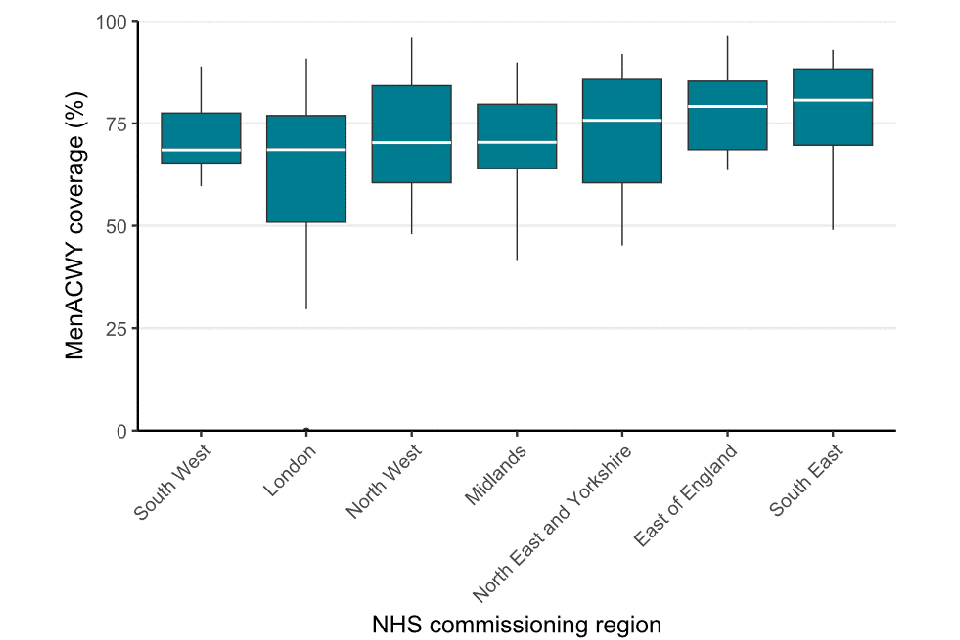
Note. Data for Lewisham has been excluded from the data set due to data quality
Figure 5 shows the geographical distribution of MenACWY vaccine coverage at the UTLA level for year 10 students in England. Coverage within ULTAs ranged from 96.3% in Hertfordshire to 29.6% in Westminster.
Figure 5. Map of year 10 MenACWY coverage by local authority
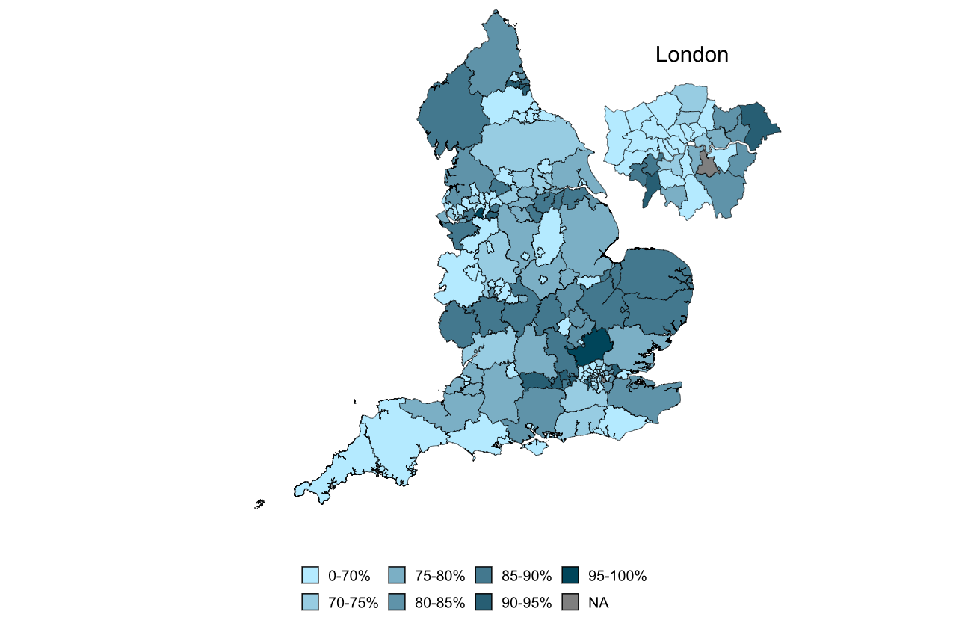
Discussion
MenACWY vaccine coverage for year 9 in 2022/23 was 68.6%. This is similar to coverage in 2021/22 and not yet back to pre-pandemic levels. Coverage in the year 10 cohort was 73.4%, which is a small improvement on uptake recorded for this cohort in year 9 during the previous academic year, suggesting ongoing catch-up activity. When coverage was calculated for each NHS comissioning region, the estimates varied considerably.
Appendix
Eligibility
2015 to 2016
In the first academic year of the MenACWY schools vaccination programme, 2 groups of adolescents were offered the vaccine in schools. These groups included:
- approximately half of adolescents in years 9 and 10 as part of the routine programme
- adolescents in year 11 as part of the catch-up campaign
2016 to 2017
The MenACWY vaccine was offered to 2 groups as part of the routine programme. These groups included:
- approximately half of adolescents in years 10 and 11 (who were in years 9 and 10 in 2015 to 2016 and were not offered the vaccine)
- the vast majority of adolescents in year 9
The vaccine was also offered through GP practices to year 13 students and opportunistically to anyone born after 1 September 1996.
2017 to 2018
The transition to routinely offer the MenACWY vaccination programme to year 9 students was almost complete, with only a small number of NHSE commissioned school-aged immunisation providers still offering the routine programme to year 10 students (who were in year 9 in 2016/17 and were not offered the vaccine).
2018 to 2019
NHS school-aged providers for 9 of the local authorities offering a year 10 programme in 2017/18 transitioned to additionally offer the vaccine to year 9 students in 2018/19.
2019 to 2020
Only a small number of NHSE commissioned school-aged immunisation providers covering 4 local authorities continued to offer the routine MenACWY programme to year 10 students routinely.
2020 to 2021
The routine offer of MenACWY vaccine to the year 9 cohort was implemented alongside catch-up for the year 10 cohort in the vast majority of local authorities.
References
1. PHE (2015). MenACWY vaccine introduction
2. JCVI (2014). Minute of the meeting on 1 October 2014
3. Department for Education (DfE) (2021). Attendance in education and early years settings during the coronavirus (COVID-19) pandemic (November)
4. DfE (2022). Attendance in education and early years settings during the coronavirus (COVID-19) pandemic (July)
5. Department of Health and Social Care (DHSC) (2021). Universal vaccination of children and young people aged 12 to 15 years against COVID-19
6. DHSC (2021). National flu immunisation programme 2021 to 2022 (letter)
